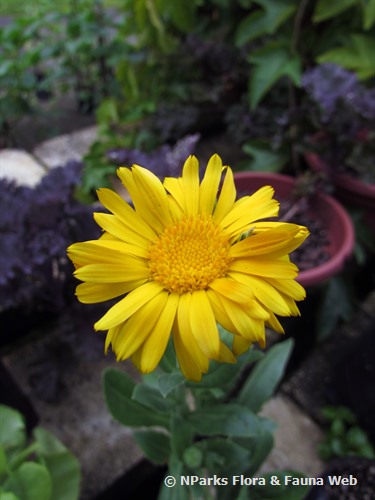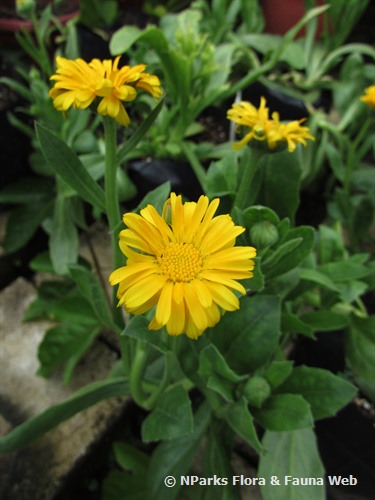
Back
Calendula officinalis L.
| Family Name: | Asteraceae (Compositae) |
| Common Name: | Pot Marigold, English Marigold, Scotch Marigold, Poet's Marigold |
Name
Classifications and Characteristics
| Plant Division | Angiosperms (Flowering Seed Plants) (Dicotyledon) |
|---|---|
| Plant Growth Form | Herbaceous Plant |
| Lifespan (in Singapore) | Perennial |
| Mode of Nutrition | Autotrophic |
| Maximum Height | 0.3 m to 0.6 m |
Biogeography
| Native Distribution | West Mediterranean |
|---|---|
| Native Habitat | Terrestrial |
| Preferred Climate Zone | Mediterranean, Temperate |
| Local Conservation Status | Non-native (Horticultural / Cultivated Only) |
Description and Ethnobotany
| Growth Form | Annual or short-lived perennial herb up to 60 cm tall. |
|---|---|
| Foliage | Leaves are aromatic, and lance-shaped to oblong shaped, measuring up to 15 cm long. |
| Flowers | Flowers are bright yellow to deep orange in colour. Flowers are daisy-like flowerheads. |
| Fruit | Dry, thorny fruit is golden brown and crescent-shaped. It is botanically classified as an achene. |
| Cultivation | Plant on fertile, well-drained soils under bright, but filtered light. Pinch plant to encourage a more bushy growth, remove spent flowers to allow additional flowering. |
| Etymology | The genus Calendula means first day of the month. The specific epithet officinalis is a reference to its medicinal use. |
| Ethnobotanical Uses | Medicinal: Traditional Medicinal Uses The flowers are used to make a tea which is said to soothe an irritated digestive system. The flower is used to treat wounds and rashes, as well as prevent infection. It is thought to reduce inflammation, control spasms and prevent fungal growth. It is taken orally and as a topical ointment. This herb may not be safe for pregnant women, as it might increase the chance of miscarriage. It is important to note that some therapeutic effects from traditional medicinal uses of plants are not currently supported or verified by scientific research. Others: The essential oil is thought to repel insects. |
Landscaping Features
| Desirable Plant Features | Ornamental Flowers |
|---|---|
| Landscape Uses | Parks & Gardens, Small Gardens, Flowerbed / Border, Container Planting |
Fauna, Pollination and Dispersal
| Fauna Pollination Dispersal Associated Fauna | Butterfly-Attracting |
|---|
Plant Care and Propagation
| Light Preference | Full Sun |
|---|---|
| Water Preference | Moderate Water |
| Plant Growth Rate | Fast to Moderate |
| Rootzone Tolerance | Moist Soils, Well-Drained Soils, Fertile Loamy Soils |
| Potential Problems | No serious pest or disease problems. May be attacked by aphids and whiteflies. |
| Diseases | Susceptible to powdery mildew. |
| Pest(s) | Sucking Insects |
| Propagation Method | Seed |
Foliar
| Foliage Retention | Evergreen |
|---|---|
| Mature Foliage Colour(s) | Green |
| Mature Foliage Texture(s) | Sticky |
| Prominent Young Flush Colour(s) | Green |
| Foliar Type | Simple / Unifoliate |
| Foliar Arrangement Along Stem | Alternate |
| Foliar Attachment to Stem | Sessile |
| Foliar Shape(s) | Non-Palm Foliage (Oblanceolate, Spathulate) |
| Foliar Venation | Pinnate / Net |
| Foliar Margin | Serrate / Toothed, Entire - Wavy / Undulate |
| Foliar Apex - Tip | Acute, Obtuse |
| Foliar Base | Cuneate |
Floral (Angiosperm)
| Flower & Plant Sexuality | Unisexual Flowers , Monoecious |
| Flower Colour(s) | Orange, Yellow / Golden |
|---|
| Flower Texture(s) | Smooth |
| Flower Grouping | Cluster / Inflorescence |
| Flower Location | Terminal |
| Flower Symmetry | Radial |
| Inflorescence Type | Head / Capitulum |
| Flowering Period | Free-Flowering |
Fruit, Seed and Spore
| Mature Fruit Colour(s) | Brown |
|---|---|
| Mature Fruit Texture(s) | Thorny / Spiny |
| Fruit Classification | Simple Fruit |
| Fruit Type |
Image Repository
Others
| Master ID | 31637 |
|---|---|
| Species ID | 6036 |
| Flora Disclaimer | The information in this website has been compiled from reliable sources, such as reference works on medicinal plants. It is not a substitute for medical advice or treatment and NParks does not purport to provide any medical advice. Readers should always consult his/her physician before using or consuming a plant for medicinal purposes. |


